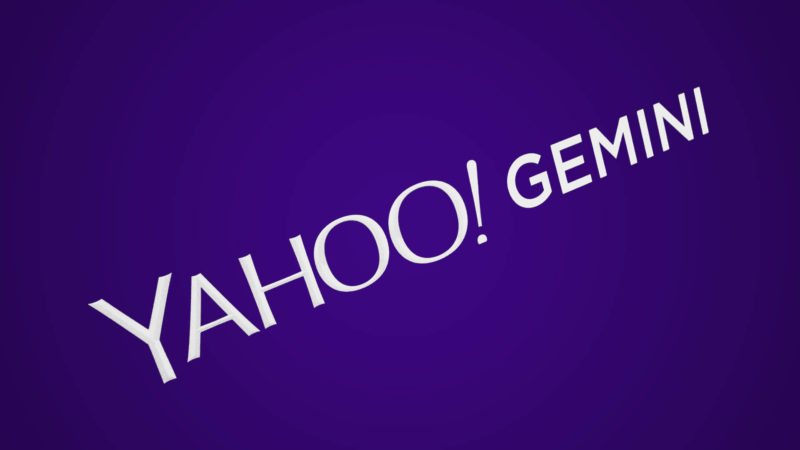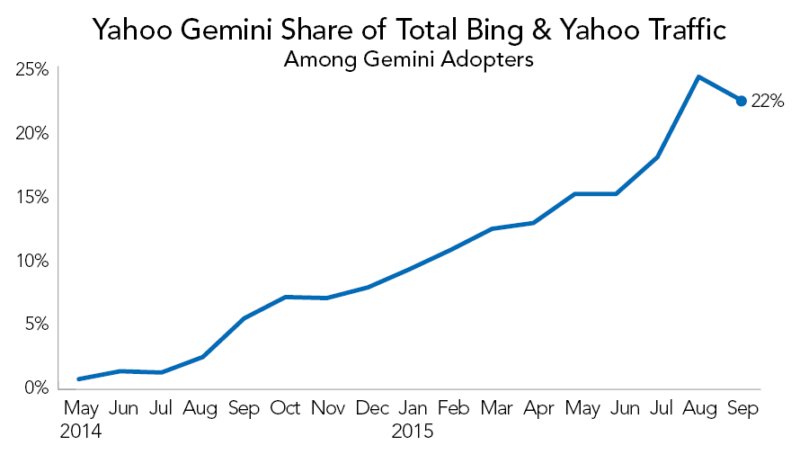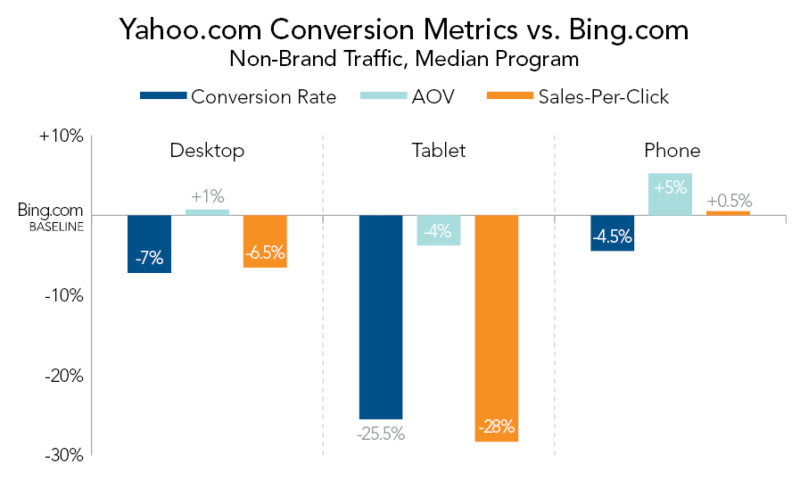As Yahoo Gemini Ramps Up, How Well Is It Performing For Search Advertisers?
For search marketers considering adding Yahoo Gemini to their advertising mix, columnist Mark Ballard of Merkle RKG shares data to help assess the potential opportunity.

Yahoo Gemini was officially announced in February 2014 as the “first unified ad marketplace for both mobile search and native advertising.” A little over a year later, Microsoft and Yahoo amended their existing partnership to allow Yahoo to serve Gemini (or any other) search ads for up to half of Yahoo’s desktop traffic.
In recent editions of the Merkle RKG Digital Marketing Report, we’ve shown how Yahoo has moved quickly to bring search ad traffic under Gemini for advertisers that have adopted the platform. For some perspective, in September 2015, Yahoo.com produced a little over 50 percent of the clicks that took place across the Bing Ads and Gemini platforms.
For advertisers adopting Gemini, Gemini produced 22 percent of combined Bing and Gemini clicks. Given the device breakdown of Yahoo’s traffic, this amounts to about two-thirds of the traffic it is able to control under the renegotiated agreement.
To be clear, not all search advertisers have adopted Gemini, so the impact it is having is likely far less overall, but it does appear that Yahoo fully intends to bring as much traffic under the Gemini platform as it is able to under their renegotiated agreement with Microsoft.
For advertisers, this means having another major US search ad platform to manage, but it could also be an opportunity for growth, depending on how well Gemini performs. I’ll get to some specific figures shortly, but first, some more context.
A Brief History Of The Search Alliance
When the search alliance between Microsoft and Yahoo originally launched in late 2010, the conventional wisdom was that Microsoft’s ads performed a lot better than Yahoo’s, and maybe even better than Google’s. It certainly depended on how you judged performance, and what seemed “better” for advertisers wasn’t necessarily good for Bing and Yahoo.
Bing ROI tended to look strong because competition was lower, but more importantly, conversion rates seemed strong on Bing because of how restrictive its broad matching was. Bing’s broad matching was effectively working like Google’s broad match modifier option, where almost every word in the keyword phrase would need to match exactly to a word in the search query for Bing to serve the ad. This makes for better converting broad match traffic, but it significantly cuts down on potential traffic volume.
For quarter after quarter in those days, you would hear a lot about how the revenue-per-search (RPS) that Bing was producing for Yahoo was not meeting Yahoo’s expectations. But over time, Microsoft significantly revamped its ad matching algorithms to the point that its broad matching was arguably more aggressive than Google’s.
The changes Bing has made to its ad matching technology were evident in some of the strong numbers Microsoft reported over mid-2013 through mid-2014 showing Bing revenues up in a range of 34–47 percent Y/Y. The impact has been far less obvious in Yahoo’s numbers, though.
According to an SEC filing from earlier this year, as of October 1, either Yahoo or Microsoft can now terminate their deal by simply providing the other party with written notice. Their agreement would remain in effect for another four months, but Yahoo would not be held to a volume commitment in the final two months of that period.
Whether it makes sense for Yahoo to do so depends on a lot of factors, including whether Yahoo is willing or able to produce its own organic search results. Also toward the top of the list is whether or not Yahoo can generate a meaningfully higher RPS for itself than Bing has.
To produce a higher RPS, Yahoo Gemini will need to deliver some combination of increased ad volume and increased ad quality (value to advertisers) over Bing Ads. Given how aggressive Bing’s ad matching has become, the latter seems like the bigger opportunity.
Is Gemini Delivering Incremental Traffic Volume?
Indeed, when we look at a comparison between Gemini adopters and all advertisers, there’s no clear indication that adopting Gemini has led to increased traffic share for Yahoo and Bing combined.

Who Has The More Valuable Traffic? Bing Or Yahoo?
If Gemini is not obviously producing incremental search ad clicks, then it must produce better quality clicks for advertisers to be willing to increase their spending for Yahoo traffic.
Currently, under the Bing Ads platform, advertisers cannot segment Yahoo traffic from Bing traffic, so the easiest way that Yahoo Gemini could produce higher-value clicks than Bing Ads is if Yahoo searchers simply convert better than Bing searchers, all else being equal. That does not appear to be the case across the programs we surveyed.
Comparing conversion metrics for search ad traffic on Yahoo.com to Bing.com, regardless of the platform through which the ad was served, we find that Yahoo.com traffic converts at lower rates across all device types.
The gap is fairly small on desktops and phones, though, and Yahoo.com traffic actually produces a slightly higher sales per click on phones than Bing.com traffic. Still, it does not appear as if the merging of Bing and Yahoo traffic, in and of itself, has been holding down the amount advertisers have been willing to pay for Yahoo traffic.
How Does Gemini Compare To Bing Ads?
Looking at a comparison of Gemini and Bing Ads traffic on Yahoo.com yields more promising results for Yahoo and its Gemini program.
Gemini ads are converting 14 percent better for Yahoo.com phone traffic than Bing Ads and 21 percent better for tablet traffic. For desktop, the two platforms are roughly at parity.
This bodes well for Yahoo, but it’s unclear how indicative these figures are of the long-term potential of Gemini. The data do not address the question of query mix, which is difficult to get a read on, even for large search programs. It’s possible that Yahoo has managed to take the cream off the top; however, Gemini clicks do appear to be relatively cheap compared to Bing’s, even after accounting for differences in traffic share across device types.
Brands ads do make up a larger percentage of Gemini traffic than Bing Ads traffic on Yahoo across all device types, but we have accounted for that in all of the conversion figures above by restricting the analysis to non-brand traffic.
Where Does This Leave Advertisers?
While Gemini has shown promise in improving the performance of mobile search ads on Yahoo.com, it does not yet appear to be driving substantially more ad volume than Yahoo would otherwise receive via Bing Ads.
This could very well reflect the fact that Gemini is a developing marketplace that advertisers are still catching on to and learning how best to approach. While the ability to segment Yahoo traffic from Bing traffic should allow advertisers to better optimize investments in both, that ability comes with its own set of challenges.
There is the additional management and IT investment that may be easier for large and/or more sophisticated advertisers to absorb, and one of the dividing lines between sophisticated search advertisers and everyone else is the ability to accurately predict the value of ad traffic in the face of sparse data. Gemini taking more traffic from Bing over time will leave advertisers with two smaller buckets of traffic to optimize that may or may not ever materially surpass their potential volume as a combined entity.
In other words, nearly all of the downsides are the reverse of everything that was supposed to be a benefit when the search alliance was launched. Still, there are plenty of advertisers that appreciate and can handle the greater control that two separate platforms will allow.
Contributing authors are invited to create content for Search Engine Land and are chosen for their expertise and contribution to the search community. Our contributors work under the oversight of the editorial staff and contributions are checked for quality and relevance to our readers. The opinions they express are their own.
Related stories
New on Search Engine Land


